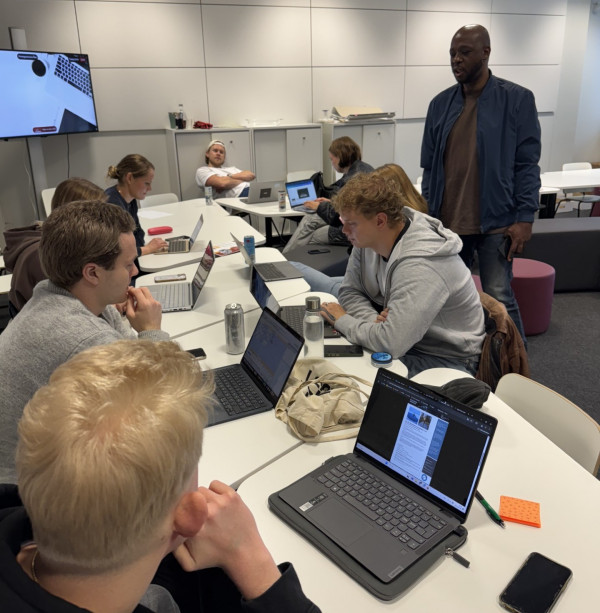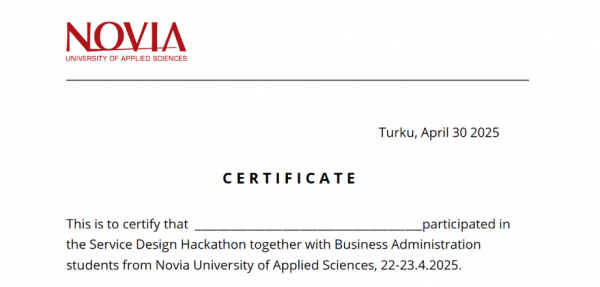
Pedagogiska bloggen
I bloggen kan du läsa om pedagogiska metoder och ta del av goda lärdomar av dina medarbetare. Bloggen skrivs av olika författare och inlägg som är granskade och godkända av Novias redaktionsråd är markerade och taggade med #granskat inlägg.
Vi följer CC BY 4.0 om inget annat nämns.
A Service Design Hackathon Brought Finnish and Lithuanian Students Together to Innovate Ideas for the Interreg Baltic Sea Region Project Light in the Dark

Introduction
A hackathon is an educational and collaborative tool to generate ideas and innovative solutions. The term "hackathon" is a blend of "hacker," meaning a clever programmer, and "marathon," indicating endurance. The idea of a hackathon is not new, and the term has been around for 20 years. It originates from creating a software project in a stipulated amount of time. Several universities and organisations around the world have been conducting competitions, where people are asked to complete a task in limited hours. (Mittal, 2022)
Hackathons or service jams have successfully been organised at Novia UAS on several occasions (see Andrésen, 2024; Andrésen & Engberg 2024). This time, the hackathon went international and hybrid, which was a new and refreshing spin on the event. Two teams with International Business of Tourism and Recreation students from Klaipeda University (KU) in Lithuania and 10 teams of Business Administration students from Novia UAS participated in the hackathon.
The planning process
Representatives from KU in Lithuania, Estonia University of Life Sciences (EMU) in Estonia, Novia UAS and Åland UAS in Finland had online planning meetings prior to the hackathon. The participants shared information and earlier experiences, and efforts were made at all the institutions to engage teachers and students in the event. Willingness to adapt the overall concept to fit with meaningful activities at the home university was required. The higher education institutions (HEIs) had to find suitable courses and/or students willing to participate in this hackathon. Marketing efforts were made by the contact persons at their own HEIs. In the end, KU and Novia UAS managed to engage students and coaches/mentors in this event.
The hackathon
A hackathon usually starts with a brief introduction to the theme underlying the event. Therefore, project manager James Simpson introduced the Interreg Baltic Sea Region project Light in the Dark to the students. He presented issues that the northern Baltic Sea coast faces, as well as research completed within the project. The students also learnt about personas and experience groups developed within the project and products created by tourism SMEs in the Baltic region. A sneak peek into the work in progress with the Light in the Dark Baltic Sea concept video was provided. The project was the commissioner of the hackathon.
What makes this kind of competition successful is the flexibility to be creative on a theme that is not so well-known beforehand. The students had 24 hours to develop a 7-day-tourism package (a tour) for the whole or part of the Baltic Sea region, for a defined target group. They were either able to further develop the existing personas and products or use them as they had been developed in the project. The plan was to provide the project Light in the Dark with suggestions and ideas on how to further develop packages within the Baltic Sea region.

Photo: Marika Nygårdas

Photo: Mathias Gröndahl
Presentations and result
All the 12 groups presented their suggestions for packages 24 hours after the kick-off. All the presentations had different strengths, and the members of the jury had to be fast at seizing the depth of the analysis, the use of service design tools, as well as the innovation and creativity of the different packages. The jury comprised Geoffrey Pororo, Service Design Expert at Novia UAS, Lea Sudakova, Nature Tourism Management Lecturer at EMU in Estonia, and Angelina Ivanova, Deputy Director at Nida culture and tourism information center Agila in Lithuania. The jury met online after the presentations and managed, despite some technical difficulties, to agree on a result. A presentation of the winning ideas follows.
Step outside of Finland, not your comfort zone - Lähde maailmalle – mukavuus mukanasi (Go out into the world – but remain within your comfort zone). The slogan of the package was We don’t provide tours. We offer people their first taste of adventure abroad — welcoming them with open arms and the thrill of new horizons. The team comprised Rasmus Lindblom, Reetta Tuovinen, Ömer Dagdeviren and Niklas Wilén and they made excellent use of a variety of service design tools when they presented the package for their target group, The Gentle Explorer.
The other winning team of the competition, The Nordic Hell Camp – Train Like a Soldier, Rest Like a Local – was an extreme adventure with a miliary twist, where the value proposition promised a military-style adventure that builds resilience, delivers personal growth, and creates lasting memories. The target group of the adventure is 25-40-year-old single males or family fathers, interested in detaching from everyday life and trying military exercises with the luxury of, at the end of the day, rest in a comfortable hut. Thim de Haas, Marek Hallbäck, Kristian Skarbö, Paulus Borgström and Nora Larrañaga were the students behind the idea of this package.
Baltic Soul Scape – Lithuania’s and Latvia’s Light in the Dark was the runner-up team in the competition. Akvilė Lukosiute, Rasa Jurciuviene, Margarita Mochrik, Sofiia Sarancha, Oleg Romaniuk and Gabija Jurgutyte comprised the KU team that presented a blend of nature, history, and culture with eco-friendly activities like smoked fish tastings and traditional craft workshops. The students made good use of existing Light in the Dark material but added their own ideas to their package.
Congratulations to the three teams that managed to stand out from the crowd.

Part of the Certificate of participation given to the hackathon's participants.
Conclusion
The international organisers of the hackathon had an online meeting afterwards, where the event was evaluated. Everybody agreed that it would be important to further develop the idea of the students, from the different HEIs, working together more intensely and efficiently than this time.
It is generally acknowledged in the theory that interdisciplinary exposure in studies can prepare students for a complex society, as the students learn to analyse and understand the world from different perspectives. Tourism students from KU and business administration students from Novia UAS participated in this hackathon. The business administration students took part in a course on service design at their home institution. Service design tools where at the heart of the event, which created an imbalance between the countries. This imbalance could have been avoided with a stronger interdisciplinary approach to the design of the task, where tourism, business and service design would have complemented each other in a more effective way.
One suggestion for the future would be to develop this hackathon into a BIP-course, where the students could meet and work together face-to-face at one of the HEIs. This solution would bridge the immediate adverse effects and consequences of uncertain connections and superficiality.
Any event needs to have committed and enthusiastic organisers, who believe in the concept and its potential to grow and develop. Luckily, the organisers of this hackathon all agreed that the event is worth developing next year. Henceforth, we can look forward to yet another Light in the Dark service design hackathon in the spring 2026 in an updated format.
References
Mittal, Pranav (2022) A brief history of hackathon. Retrieved from: https://content.techgig.com/codegladiators2021/a-brief-history-of-hackathon/articleshow/75291637.cms
Andrésen, A & Engberg, M (2024). Intercultural Hackathon on Inclusive Leadership at Novia Business 3-4.10.2024. Novialia. Retrieved from: https://novialia.novia.fi/bloggar/pedagogiska-bloggen/intercultural-hackathon-on-inclusive-leadership-at-novia-business-3-4-10-2024
Andrésen, A (2024). Light in the Dark- Design Jam. Novialia. Retrieved from https://novialia.novia.fi/bloggar/fui-bloggen/light-in-the-dark-design-jam-
Texten har granskats och godkänts av Novias redaktionsråd 14.5.2025.
![]()
Pedagogiska bloggen
I bloggen kan du läsa om pedagogiska metoder och ta del av goda lärdomar av dina medarbetare. Bloggen skrivs av olika författare och inlägg som är granskade och godkända av Novias redaktionsråd är markerade och taggade med #granskat inlägg.
Vi följer CC BY 4.0 om inget annat nämns.
Ansvarsfriskrivning: Författaren/författarna ansvarar för för fakta, möjlig utebliven information och innehållets korrekthet i bloggen. Texterna har genomgått en granskning, men de åsikter som uttrycks är författarens egna och återspeglar inte nödvändigtvis Yrkeshögskolan Novias ståndpunkter.
Disclaimer: The author(s) are responsible for the facts, any possible omissions, and the accuracy of the content in the blog.The texts have undergone a review, however, the opinions expressed are those of the author and do not necessarily reflect the views of Novia University of Applied Sciences.